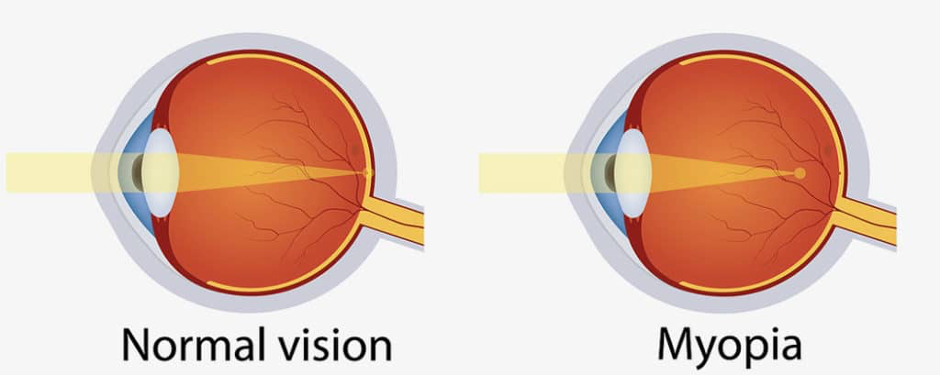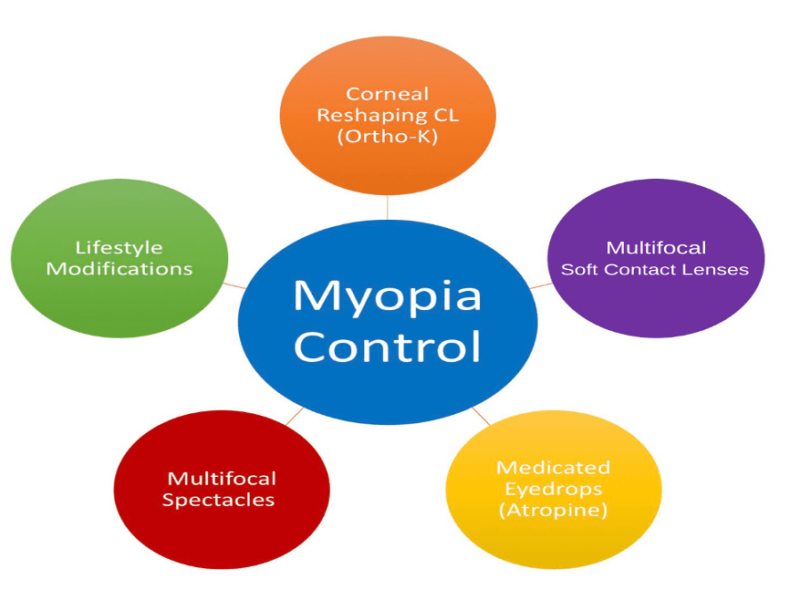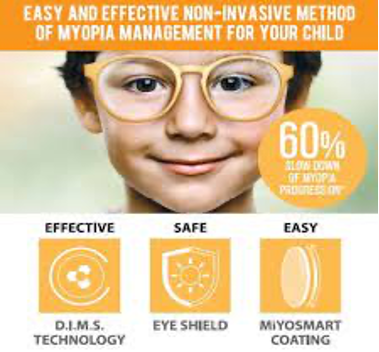What is myopia?
Myopia, otherwise known as short-sightedness, or near-sightedness, is a common eye condition that causes objects in the distance (such as TV and the whiteboard), to appear blurred, while close objects are often seen clearly. Having myopia is not an indication that your child’s eyes are in poor eye health.
Myopia occurs when the eye has too much focusing power, either due to the eye being too long or because the cornea (the front of the eye) is more curved than usual. As a result, when viewing distant objects, rays of light focus in front of the retina (the back of the eye), rather than directly onto it, causing the appearance of those objects to appear blurred.

Genetics & environment
Over the past few years, research has demonstrated that genetic and environmental factors can influence myopia.
For instance, children are more likely to be myopic if their parents are as well. In addition, children and teenagers are spending increasing amounts of time on digital devices and less time outdoors, where they would receive the benefits of natural daylight.
Will my child’s myopia get worse?
Whilst every child is different, their lifestyle, family history and age will influence how their myopia worsens overtime.
You can help by encouraging your child to:
- Avoid spending long periods of time viewing near tasks, including reading books and digital devices
- Spend at least 90 minutes per day outside in natural daylight If your child starts to show signs of myopia at a young age, it is likely that this will continue to get worse over time. This means they will grow up relying more on contact lenses and/or or spectacles, to see everyday things.

What is myopia management?
Conventional spectacles or contact lenses give your child clear vision. Myopia management is different, as it aims to reduce excessive growth of your child’s eyes and subsequently how quickly their myopia develops over time.
There are products available for children requiring myopia management, including:
- Contact lenses
- Spectacles
- Eye drops (not currently used or licenced in the UK).
- We will take time to assess your child and discuss the most appropriate option based on their age, level of myopia and their lifestyle and motivation. Your child’s myopia may still develop even if they undergo myopia management.
Why has my practitioner advised myopia management?
Research has shown that myopia is on the increase across the globe. Children are becoming myopic at a younger age and the level of their myopia is getting worse. It is important that we explain to you the options available to your child. Practical reasons for considering myopia management include:
- Potentially slowing down progression of myopia and lower prescriptions in adulthood
- Thinner and lighter spectacle lenses.
- Less blurry vision without spectacles or contact lenses.
- May avoid limitations in career choice, where good vision is essential.
- More predictable outcomes for refractive surgery to correct vision should this be important to your child in the future.
- Supports good eye health into adulthood.
- Myopia has been associated with certain eye conditions that may impact the quality of your child’s vision in the future. These include cataracts, glaucoma, retinal detachment, and myopic maculopathy.
What options are there for myopia management?
We can talk through the options available to your child and provide our recommendation. These recommendations may include:
Soft contact lenses
This is an ideal option for most children with active lifestyles, who would benefit from the freedom of not wearing spectacles. Soft contact lenses are generally easy to handle and well-accepted by children. Your ECP will recommend how many hours a day these should be worn.
Dual-focus contact lenses
Dual-focus contact lenses are specifically designed for younger eyes and indicated for myopia management.
Orthokeratology (Ortho-K)
Special Rigid Gas Permeable (RGP) contact lenses. Ortho-k lenses act like a ‘brace’ for your eye and flatten the cornea (the front of the eye) at night while the wearer sleeps. This provides clear vision throughout the day, without the need for spectacles or contact lenses. This is an ideal option for those children who would benefit from being spectacle and contact lens free during the day, for example when swimming. Ortho-k fitting requires several follow-up appointments over the first few weeks and for maximum treatment effect, it is important that ortho-k lenses are worn every night and replaced every 6 months. Please see separate leaflet.
Spectacle lenses
Designed for myopia management differ in design to conventional spectacle lenses.

MiYOSMART Lens
They may be worn as a standalone option, or on days when it is not convenient to wear contact lenses. Spectacles are also a good option for children who are nervous about, or unable to wear, contact lenses.

Atropine eye drops
Atropine eye drops are currently not widely available in the UK and not licensed for myopia management. In other countries, e.g., Far East they are often used. These eye drops (applied to both eyes at night) do not correct vision and must be used in conjunction with spectacles or contact lenses during the day. Usage of atropine in this way is sometimes called ‘combination therapy’ and research in this area is still ongoing.
Other considerations
Although complications and eye infections due to contact lens wear are rare, they may occur. Research has shown that young children have very low rates of eye infections with both soft contact lenses and Ortho-K. The risk of eye infections or complications can be minimised by maintaining strict hygiene practices, attending follow up appointments and following our guidance.
